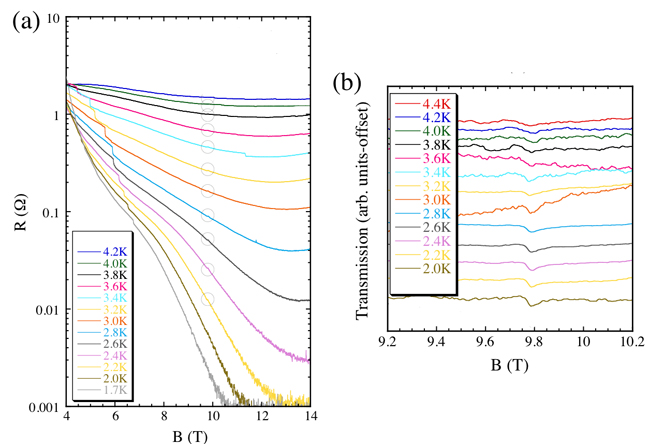Synthesis, characterization, and design of molecular materials, especially molecular conductors (including superconductors), have been undertaken. Molecular conductors exhibit a variety of physical properties which can be systematically understood on the basis of "simple" and "clear" electronic structures. From a chemical point of view, the most fascinating character of the molecular conductor is its "designability", that is, we can finely control solid state properties with chemical modifications of the molecule. The newly synthesized materials are characterized by the X-ray diffraction method and physical measurements (electrical conductivity...etc.). The electronic structure is investigated by the simple band structure calculation. All these results are devoted to the design of new molecular materials.
- Development of molecular conductors based on novel metal dithiolene complexes
- Field effect measurement of molecular conductors on silicon substrate and organic Mott-FET
- Massless Dirac Fermions in organic conductors
- Photo-induced phase transition in BEDT-TTF salts
- Control of the electronic states in molecular conductors by use of dynamical external fields
(2) High pressure electrical properties of a single component molecular crystal [Ni(dmit)2] with small ligand
(3) The electrical properties of single component molecular crystals [M(dddt)2] (M=Ni, Pd) under very high pressure
(4) Physical properties of Pd(dmit)2 salt with fluorinated onium cations
(5) Structures and physical properties of platinum-dmit salts
(6) Dielectric constant of Pd(dmit)2 salts
(7) In-depth study of the phase diagram of EtMe3P[Pd(dmit)2]2
(8) First-principles study on structural and electronic properties of (Cation)[Pd(dmit)2]2
(9) Development of novel bi-layer Ni(dmit)2 anion radical salts
(10) Development of novel molecular magnetic conductors with Ferrocene-TTF hybridized organic donors
(2) Field-effects in κ-(BEDT-TTF)2Cu[N(CN)2]Cl near the Mott transition
(2) Interband effects of magnetic field on Hall conductivity
- Development of molecular conductors based on novel metal dithiolene complexes
- Field effect measurement of molecular conductors on silicon substrate and organic Mott-FET
- Massless Dirac Fermions in organic conductors
- Photo-induced phase transition in BEDT-TTF salts
- Control of the electronic states in molecular conductors by use of dynamical external fields
Metal dithiolene complexes have provided a variety of molecular conductors. Among them, most of anion radical salts of Pd(dmit)2 (Scheme) belong to a strongly correlated two-dimensional system with a quasi triangular lattice of [Pd(dmit)2]2- dimers. The conduction band originates from HOMO, which is associated with the srong dimerization and a small HOMO-LUMO energy splitting. Their electronic state is associated with various degrees of freedom (including charge, spin, orbital, and lattice) and can be tuned by pressure and counter cations.
(1) Quantum spin liquid state in a molecular conductor β'-EtMe3Sb[Pd(dmit)2]2
Assign: Kato, Yamamoto, Cui, Yamashita; A. Tajima, N. Tajima, Ishii, Fukunaga, Kubo
The interplay between frustration and strong electronic correlations in quasi-two-dimensional molecular conductors with triangular lattices generates a wide range of exotic phases including spin liquid, valence bond solid, charge order, and unconventional superconductivity. The series of anion radical salts β'-X[Pd(dmit)2]2 (X: closed-shell monovalent cations EtxMe4-xZ+, where x = 0-2 and Z = P, As, Sb) represents an important class of model systems for investigating quantum frustration. Among them, we now focus on three isostructural salts with X = Me4Sb, EtMe3Sb, and Et2Me2Sb. At ambient pressure, all these salts are Mott insulators and belong to a spin-1/2 system with antiferromagnetic Heisenberg interactions. The Pd(dmit)2 molecules in the β'-type crystal structure are strongly dimerized. Interdimer transfer integrals between the frontier molecular orbitals indicate that the dimer units form a quasi-triangular lattice within the anion layer and that spin frustration occurs. The ground states of these salts vary drastically depending on the choice of cation. The Me4Sb salt exhibits antiferromagnetic long-range order (AFLO). The Et2Me2Sb salt undergoes a charge order (CO) transition. The EtMe3Sb salt exhibits no indication of spin ordering/freezing down to 19.4 mK (less than 0.01% of the exchange coupling J) and there is strong evidence for a quantum spin liquid (QSL) ground state. Interdimer transfer integrals t and t' are key parameters in β'-X[Pd(dmit)2]2. The ground state is classified by the ratio t'/t, which can be tuned by the choice of cation X (Figure 1). Tuning t'/t from 0.6 (X = Me4P) to 1.0 (X = Et2Me2Sb), changes the ground state from AFLO to CO through QSL so that the QSL state of this system is situated between AFLO and CO. These three states compete around X = EtMe3Sb (t'/t = 0.9). This study seeks to fine tuning of t and t' by mixing Me4Sb or Et2Me2Sb into the EtMe3Sb site. Since these three stibonium cations are similar to each other, we expect homogeneously mixed crystals and fine tuning of the lattice parameters.
The mole fraction of each cation in the mixed crystal was determined by ESI-MS. Figures 2 and 3 show the EtMe3Sb content of the crystal (x) as a function of that in the reaction solution. Mass spectrometric analysis revealed that the molar ratios of different crystals vary very little (variability was c.a. 1%) and that the mixed crystals are homogeneous. Increasing the number of ethyl groups at the cation site reduces the anisotropy of the triangular lattice, and the dimer units form an almost regular triangular lattice in pure Et2Me2Sb salt. In this process, the Pd(dmit)2 molecule is slightly curved to exhibit a crescent shape. This distortion plays an important role in tuning the interdimer transfer integrals.
In the EtMe3Sb/Et2Me2Sb mixed crystals, the CO transition was suppressed rapidly, and the crystals with x>0.2 showed QSL-like behavior. In the Me4Sb/EtMe3Sb mixed crystals, the Neel temperature was lowered by increasing x, and the crystals with x>0.36 showed QSL-like behavior. The low-temperature heat capacity and magnetic susceptibility for pure EtMe3Sb salt and mixed salts provided the Wilson ratio close to 1, which suggests that the QSL state in the Pd(dmit)2 system is a Fermi-liquid like state.
For these Pd(dmit)2]2 salts, determination of the electronic heat capacity was hindered by thermal anomaly below 1 K which is considered to originate from quantum methyl rotation in the cation. We successfully synthesized fully deuterated EtMe3Sb cation and its dmit salt this year. Deutrated samples will make it possible to measure pure electronic heat capacity. ( dmit= 1,3-dithiole-2-thione-4,5-dithiolate )
 Scheme: Pd(dmit)2 |
 Figure 1: Phase diagram of β'-Pd(dmit)2 system where t and t' are interdimer transfer integrals. FP; Frustrated paramagnetic state, AFLO; Antiferromagnetic long-range ordered state, QSL; Quantum spin liquid, CO; Charge ordered state |

Figure 3(right): Mole fraction of EtMe3Sb in crystal (x) as a function of that in reaction solution for (Et2Me2Sb)1-x(EtMe3Sb)x[Pd(dmit)2]2
(2) High pressure electrical properties of a single component molecular crystal [Ni(dmit)2] with small ligand
Assign: Cui, Tsumuraya, Kato; Miyazaki, Okano
Since the discovery of the first single component metal [Ni(tmdt)2], the explore of organic single component metal have attracted considerable attention in recent years. The trouble is that it is very difficult to grow large single crystals of single component molecular metals. On the other hand, semiconducting or insulating molecular crystals can provide single crystals with operable size. Because the molecular system has soft lattice and the electronic structure is sensitive to pressure, the external high pressure can enrich a list of new single component molecular metals. We synthesized a neutral molecule crystal [Ni(dmit)2 and measured the high pressure electrical resistivity up to 25.5 GPa. We successfully observed a metallic state in the wide temperature range above 15.9 GPa. Two different band calculation methods, the tight-binding calculation and the ab initio calculation, indicated that small Fermi-surfaces appear under high pressure, respectively. (tmdt = trimethylenetetrathia fulvalenedithiolate, dmit= 1,3-dithiole-2-thione-4,5-dithiolate )
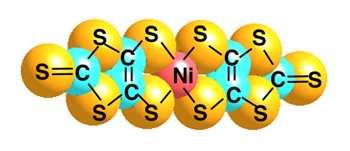
[Ni(dmit)2]
(3) The electrical properties of single component molecular crystals [M(dddt)2] (M=Ni, Pd) under very high pressure
Assign: Cui, Kato
We synthesize two kinds of single component molecular crystals M(dddt)2] (M=Ni, Pd). Systematic high pressure electrical resistivity measurements were performed up to 21.6 GPa. They are isostructural, and both of them are insulators at ambient pressure. Resistivity of [Ni(dddt)2] was measurable above 5 GPa, and the room temperature resistivity decreased with increasing pressure up to 10 GP. However, very little pressure dependence of resistivity was observed above 10 GPa. On the other hand, resistivity of [Pd(dddt)2] was measurable above 3GPa, and the activation energy sharply decreased with increasing pressure. Semimetallic temperature dependence of resistivity was shown at 12 GPa. However, above 12 GPa, this salt turned more resistive.
(dddt=5,6-dihydro-1,4-dithiin- 2,3-dithiolate)
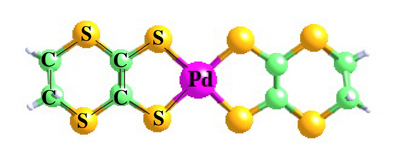
[Pd(dddt)2]
(4) Physical properties of Pd(dmit)2 salt with fluorinated onium cations
Assign: Nomura, Cui, Abdel Jawad, Tsumuraya, Oshima, Yamamoto, Kato; A. Tajima
Most anion radical salts of the Pd-dithiolene complex [Pd(dmit)2] are Mott-insulators at ambient pressure. The [Pd(dmit)2]2 dimer units form a triangular lattice in the crystal and then provide interplay between electron correlation and spin frustration. We can precisely tune the electronic properties by applying physical stimuli to the crystal or chemical modifications (chemical pressure). In the [Pd(dmit)2]2 salts with quaternary onium cations, the so-called β- or β'-(R4Z)[Pd(dmit)2]2 (R = Me and Et; Z = N, P, As and Sb), a chemical modification of the R4Z+ cation systematically controls inter-dimer transfer integrals and thus anisotropy of the triangular lattice. However, one synthetic issue has been that an introduction of bulky R groups changes the crystal structure type.
Accordingly, we carried out 'slight modification' of the (R4Z)[Pd(dmit)2]2 salt by fluorination of the R group (Figure 4), because the van der Waals radius of fluorine atom is comparable with that of hydrogen atom. In fact, the crystal structure did not change by the fluorination, but the electrical and magnetic properties were drastically modified by tuning anisotropy of the triangular lattice. We have already reported metallic behavior of the fluorinated ammonium salt β-[(FCH2)Me3N][Pd(dmit)2]2 at ambient pressure. The fluorinated phosphonium salt β'-[(FCH2)Me3P][Pd(dmit)2]2 also showed metallic property under the same condition (Figure 5). These results are different from those for the non-fluorinated salts. The β-(FCH2)Me3N salt demonstrated temperature independent magnetic susceptibility in the high temperature region, suggesting Pauli paramagnetic behavior. Below 16 K, an antiferromagnetic long-range order appeared. Temperature dependence of the magnetic susceptibility of β'-(FCH2)Me3P salt was well described by a two-dimensional triangular antiferromagnetic Heisenberg model in the high temperature region. An antiferromagnetic transition occurred at 29 K. We consider that the fluorinations of the cation can provide anisotropic chemical pressure to the triangular lattice and an enhancement of bandwidth. This explains metallic behavior of the β-(FCH2)Me3N and β'-(FCH2)Me3P salts. Actually, the b axes of the fluorinated salts were shorter than those of the corresponding non-fluorinated salts. An interdimer transfer integral tS is along the b axis (the side-by-side direction; Figure 6). Notably, the Me4N salt easily shows metallic (and superconducting) behavior under uniaxial strain along the b axis. This suggests that a pressure effect along this direction is important for the modification of electrical properties.
(dmit= 1,3-dithiol-2-thione-4,5-dithiolate)
 Figure 4:[Pd(dmit)2]2 salts with fluorinated onium cations  Figure 6:Triangular lattice of the [Pd(dmit)2]2 dimers. The crystal b axis is parallel to tS. |
 Figure 5:Temperature- and pressure-dependences of electrical resistivity of β'-[(FCH2)Me3P][Pd(dmit)2]2 |
(5) Structures and physical properties of platinum-dmit salts
Assign: Nomura, Cui, Abdel Jawad, Tsumuraya, Oshima, Kato; A. Tajima
We can control electronic properties of Mott-insulators with a triangular lattice of the dimer units, β- or β'-(R4Z)[Pd(dmit)2]2, by a chemical modification of the R4Z+ cation, because degree of the interdimer transfer integrals and thus anisotropy of the triangular lattice can be controlled. On the other hand, we are interested to control the intradimer transfer integral by Pd/Pt substitution, because an intradimer M…M distance would be modified. However, β- or β'-(R4Z)[Pt(dmit)2]2 salts were rarely reported. To our knowledge, only β-(Me4N)[Pt(dmit)2]2 was reported.
In this work, the (R4Z)[Pt(dmit)2]2 salts, where R4Z+ = Me4N+, (FCH2)Me3N+, Me4N+, Me4P+, Me4As+ and Me4Sb+, were obtained by electrochemical oxidation (Figure 7). The (FCH2)Me3N salt was afforded as the β-form. Most Me4N salt crystals belonged to the β-form but the β-form crystals were found as a minor component. Other salts (R4Z+ = Me4P+, Me4As+ and Me4Sb+) belonged to the β'-form. The [Pt(dmit)2] molecules in the β-Me4N and β-(FCH2)Me3N salts were dimerized with Pt…Pt distance of 3.16 Å, which were comparable with Pd…Pd distances in Pd(dmit)2 salts. In γ- and β'-salts, the [Pt(dmit)2] molecules were dimerized more weakly (Pt…Pt = 3.23-3.30 Å). The band structure of the Pt(dmit)2 system obtained by the first-principles calculations demonstrated HOMO-LUMO band inversion as shown in the Pd salts. In contrast to the Mott-insulating Pd salts, β-(FCH2)Me3N and other β'-Me4Z salts of [Pt(dmit)2] showed metallic behavior in the high temperature region under ambient pressure (Figure 8). The reduction of on-site Coulomb energy associated with the weak dimerization would explain the metallic behavior. Most [Pt(dmit)2] salts showed a metal-insulator transition in low temperature region. The low temperature X-ray structure analysis and magnetic susceptibility measurements revealed structural changes and non-magnetic states below TC (158-215 K). These results indicate charge-ordered states with neutral (0) and divalent (-2) dimers below the TC.
 Figure 7:[Pt(dmit)2]2 salts with quaternary onium cations |
 Figure 8:Temperature dependences of resistivity of β'-(Me4Z)[Pt(dmit)2]2 salts under ambient pressure |
(6) Dielectric constant of Pd(dmit)2 salts
Assign: Abdel Jawad, Kato; N. Tajima
A systematic study of the dielectric constant in the β'-type Pd(dmit)2 salts shows anomalous behavior throughout this class of highly dimerized charge transfer salts. The anomaly is best described as a relaxor-like response of the dielectric constant implying the presence of both electrical dipoles and substantial amount of disorder. This anomaly was first reported in κ-(BEDT-TTF)2Cu2(CN)3, another dimer Mott insulator known for its highly frustrated lattice of dimer unit. We suspect that this behavior is common to most dimer Mott insulator and that the origin of the dipole moment is the charge confined between the two large molecules of the dimer unit, except for the Et2Me2Sb salt in the charge ordered state.
Estimates of the dipole moment from the Curie constant, extracted from the Curie-Weiss increase of the dielectric constant, show almost no variation throughout the β'-type Pd(dmit)2 salts. On the other hand, the Curie temperature which is related to the ground state internal field, shows a systematic increase with correlation effect (tA/W where tA is the intra-dimer transfer integral and W the bandwidth), except for the spin-liquid candidate EtMe3Sb[Pd(dmit)2]2 and compounds with close electronic properties. Further work is required to clarify if this decrease is related to the geometric frustration or to a critical end-point between the ground state charge ordered compound Et2Me2Sb[Pd(dmit)2]2 and the antiferromagnetic Mott-insulator compounds with cations Me4P, Me4As, EtMe3As, Et2Me2P, Me4Sb, Et2Me2As. (dmit= 1,3-dithiol-2-thione-4,5-dithiolate)
 Figure 9:Frequency and temperature dependence of the dielectric constant of Et2Me2Sb[Pd(dmit)2]2, EtMe3Sb[Pd(dmit)2]2 and Me4P[Pd(dmit)2]2. |
 Figure 10:Variation with correlation of the Curie temperature extracted from the dielectric data in the β'-type Pd(dmit)2 salts. Note that the tA/W estimate of the Et2Me2Sb cation is related to the room temperature value of the crystal structure. |
(7) In-depth study of the phase diagram of EtMe3P[Pd(dmit)2]2
Assign: Abdel Jawad, Kato; N. Tajima, Watanabe, Ishii
We have seen an unusual behavior of the Hall coefficient with temperature in an dimer Mott system EtMe3P[Pd(dmit)2]2 at a precise temperature and pressure region of the phase diagram. To confirm and understand the origin of this effect, we have begun an in-depth study of the phase diagram using helium as pressure medium. Resistance data from Figure 11 unable us to estimate the critical endpoint of the Mott transition to be approximately 33.5K in temperature and 1765 bar in pressure. We have also estimated the critical exponent (δ, β, γ) of this transition to be (3/2, 2, 1) (Figure 12) which compared to the universality classes values (3, 1/2, 1) is unconventional and differ from the values of κ-(BEDT-TTF)2Cu[N(CN)2]Cl, another dimer Mott compound, where (δ, β, γ)=(2, 1, 1). Further work is under progress to understand some of those strange results.
 Figure 11:Resistance of EtMe3P[Pd(dmit)2]2 under isothermal pressure sweeps conditions. |
 Figure 12:Scaling plot of the metallic region of all the data in Fig 24. ΔP is the pressure difference to the first order line (T |
(8) First-principles study on structural and electronic properties of (Cation)[Pd(dmit)2]2
Assign: Tsumuraya, Kato; Miyazaki
Most of β'-Pd(dmit)2 compounds are Mott insulators at ambient pressure. Electronic structure of β'-Pd(dmit)2 salts with various kinds of cations has been investigated on the basis of first-principles calculations based on the density functional theory (DFT). It has been reported that anisotropy of the electronic structures are closely related to their structural properties of Pd(dmit)2 dimers by performing band structure calculations based on the extended Hückel method and the tigh-binding approximation; crystal structures determined by experiments show that inter atomic distances of Pd(dmit)2 molecules and an anisotropy of the two-dimensional quasi triangular networks in terms of the Pd(dmit)2 dimers are slightly different from one to another Pd(dmit)2 salt. The structural differences enhance electronic structures such as band widths and tight-binding parameters. Our first-principles DFT method also shows a similar trend of electronic structures depending on types of cation. We also found that the Fermi surfaces exhibit the anisotropy of the electronic structures in terms of two-dimensional quasi triangular networks. Figures 13 and 14 show Fermi surface of Et2Me2Sb and Me4P salts, respectively. In the Et2Me2Sb salt, two ellipses are almost overlapped, while those in the Me4P salt inclines toward different directions, and the orbital nodes are developed. These nodes may originate from interlayer interactions across the cations layers. Structural optimizations for atomic geometries have been performed within generalized gradient approximation. Small differences in structural properties in Pd(dmit)2 dimers are fairly good agreement with experiments. We are now in progress to investigate relation between the structural properties and the anisotropy in the electronic structures.


Figure 13(left): Fermi surface of Et2Me2Sb[Pd(dmit)2]2
Figure 14(right): Fermi surface of Me4P[Pd(dmit)2]2
(9) Development of novel bi-layer Ni(dmit)2 anion radical salts
Assign: Kusamoto, Yamamoto, Oshima, Yamashita, Kato; N. Tajima
We focused on alkyl-monohalothiazolium cation to develop novel bi-layer Ni(dmit)2 anion radical salts. Since the monohalothiazolium cation is less bulky than the dihalopyridinium cation previously used for the preparation of the bi-layer salts, denser packing of Ni(dmit)2 anion radicals is expected. In this study, we prepared (Et-4BrT)[Ni(dmit)2]2(Figure 15: Scheme)and investigated the crystal and electronic structures as well as the electronic and magnetic properties. Single crystal X-ray diffraction measurement revealed the bi-layer character of this salt, where two crystallographically independent Ni(dmit)2 anions (anions A and B) form crystallographically independent layers in the unit cell (Figure 16). Both halogen bonding between Brcation…Sanion and Scation…Sanion atomic contacts would contribute to construct the bi-layer structure. The band structure calculation as well as the conducting and magnetic measurements revealed this salt was a bi-layer Mott insulator, in which both Ni(dmit)2 anion layers are in the Mott insulating state. Detailed magnetic investigations for this salt disclosed coexistence of antiferromagnetic layer and ferromagnetic layer below 30 K (Figure 17). Furthermore, large negative magnetoresistance (-75 % at 7 T) was observed at 4 K under 1 GPa.
 Figure 15:(Et-4BrT)[Ni(dmit)2]2 |
 Figure 16:Crystal structure of (Et-4BrT)[Ni(dmit)2]2 |
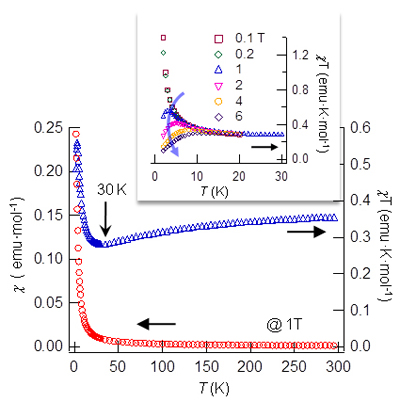
Figure 17:Temperature and magnetic field dependence of the magnetic properties of (Et-4BrT)[Ni(dmit)2]2
(10) Development of novel molecular magnetic conductors with Ferrocene-TTF hybridized organic donors
Assign: Kusamoto, Kato
Molecular magnetic conductors are focused on as a multi-functional molecular solid exhibiting both electric conduction and magnetism. In this system, interaction between conducting electrons and localized spins can produce vivid physical properties such as gigantic magnetoresistance and field-induced superconducting state. The development of novel physical properties based on such an electron-electron interaction is quite important to establish a new science in the field of condensed matter physics.
We designed new organic donor molecule FcS4TTF(R)2 to prepare molecular magnetic conductors exhibiting novel physical properties with a new mechanism. This molecule is composed of two electron-donor moieties; ferrocene (Fc) and tetrathiafulvalene (TTF). Figure 18 depicts a redox behavior of this molecule. In state C, proximity of local spin and π-radical can produce an effective electron-electron interaction leading to interesting physical properties, independent of its crystal structure. Meanwhile, if we can switch two states A and B (Figure 18) by external stimuli such as heat and light, novel molecular conductor showing switchable physical properties can be realized based on A-B interconversion. An operative electronic interaction between the Fc and TTF moieties is a crucial factor to achieve above expectations.
We established a practical synthetic route for FcS4TTF(R)2(R = SMe, CF3)in this year. The cyclic voltammograms (in PhCN, room temperature) of these molecules were measured and compared with those of the related compounds. We found that one-electron oxidation of FcS4TTF(SMe)2 removed a electron from TTF moiety to yield π-radical (state A), whereas FcS4TTF(CF3)2 formed local spin on the Fc moiety (state B) upon oxidation. These results mean that we can control a relative stability between the two states A and B by changing R in FcS4TTF(R)2, which correspond to tune the donor strength of the TTF moiety.

Figure 18:Molecular structure and redox behavior of FcS4TTF(R)2
(1) Control of electronic phases by gate electric-field
Assign: Yamamoto, Suda, Kimura, Kato
Molecular conductors (organic charge transfer salts) provide various Mott-type semiconductors whose insulating phase is directly connected to metallic/superconducting phases in their phase diagrams (Figure 19). We have fabricated FET structure with a thin-layer single crystal of κ-(BEDT-TTF)Cu[N(CN)2]X (X = Br or Cl) laminated on a SiO2/Si substrate in order to realize a Mott-transition FET as well as a superconducting FET with organic materials.
This year we have measured FET devices made of Mott-insulators such as (BEDT-TTF)(TCNQ), (BEDT-TTF)2CuCl2, and EtMe3P[Pd(dmit)2]2, as well as a charge-ordered insulator α-(BEDT-TTF)2I3. The former three materials exhibited ambipolar characteristics whose device mobilities were not very high. Improvement of interface quality is necessary to obtain intrinsic value for these materials. The charge-ordered material showed, on the other hand, n-type FET behavior and negative trans-conductance in the high-gate-voltage regime. This seems to originate from enhanced impurity scattering under thin active layer thickness.
Another result obtained by measuring κ-(BEDT-TTF)Cu[N(CN)2]Br-based FET with high-k dielectric is a switching behavior of Josephson junction network which can be controlled by the gate voltage. In a percolative superconductivity region, it is possible to increase/decrease the fraction of superconducting area by changing temperature, magnetic field, or gate voltage (Figure 20). This allows one to switch the device between resistive and zero-resistance states in real time. The detail of this device is now under investigation.
(BEDT-TTF = bis(ethylenedithio)tetrathiafulvalene, TCNQ = tetracyanoquinodimethane)


Figure 20(right): Schematic image of Mott-FET switching in a percolative superconductivity regime. The channel material is κ-(BEDT-TTF)2Cu[N(CN)2]Br. SC: Superconductor, MI: Mott-insulator, JJ: Josephson junction.
(2) Field-effects in κ-(BEDT-TTF)2Cu[N(CN)2]Cl near the Mott transition
Assign: Suda, Yamamoto, Kato
κ-(BEDT-TTF)2Cu[N(CN)2]Cl(κ-Cl) is a strongly-correlated molecular conductor and the competition between the electron-electron Coulomb repulsion and the kinetic energy is highlighted, resulting in the pressure-induced bandwidth-controlled Mott transition. Recently, we have demonstrated an electric field-induced Mott transition in a thin-single crystal of κ-Cl. We present here the electrostatic carrier doping (ESD) into κ-Cl near the band-width-controlled Mott transition. We fabricated a single crystal FET of κ-Cl with a plastic substrate. The combination of ESD and strain effects induced by bending the substrate enables coregulation of "bandwidth" and "band-filling" in κ-Cl. The κ-Cl on the substrate exhibited a superconducting behavior due to the positive pressure from the substrate. The κ-Cl showed a superconductor-to-insulator transition by applying the strain-effects (effectively negative pressure). Successively, we tried ESD into the κ-Cl under the strain. Interestingly, we found the field-effects also in the mixed state occurred during the Mott transition (Figure 21). Remarkable device mobility, ca. 280 cm2/Vs was obtained in this region although the ON/OFF ratio was only 10 %. These abnormal field-effect and device mobility indicates that the superconducting fraction emerged by ESD into the insulating phase in the mixed state. This result suggests that the field-induced superconductivity will be possible by increasing the number of injected carriers.

Assign: Suda, Yamamoto, Kato; N. Tajima
In this work, we investigated the magnetotransport of massless Dirac Fermions system α-(BEDT-TTF)2I3. The purpose is to clarify the nature of Dirac particles in this system. This system exhibits various types of electronic states when the magnetic field is applied along in-plane or out-of-plane.
(1) Field effect transistor
We succeeded in operating the field effect transistor in Dirac fermion system α-(BEDT-TTF)2I3 at low temperatures using thin crystals. This effect was very weak. However, we could detect the effects of zero-mode Landau carriers including its spin-splitting in the transport.
(2) Interband effects of magnetic field on Hall conductivity
In contrast to graphene, the electron-hole symmetry of α-(BEDT-TTF)2I3 is not good except at the vicinity of the Dirac points. Thus, temperature dependence of the chemical potential plays an important role in the transport in this system. The experimental formula of the chemical potential was written as μ=EF-0.24kT. We succeeded in detecting the inter-band effects of a magnetic field on the Hall conductivity when the chemical potential passes the Dirac point.
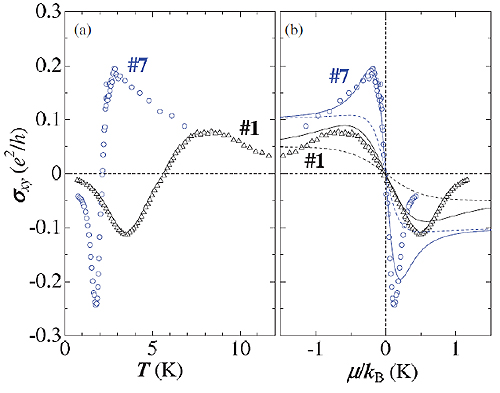
Assign: Takubo, Yamamoto, Kato; N. Tajima
We have studied photo-induced phase transition (PIPT) by focusing on photo-induced charge-order (CO) melting in BEDT-TTF salts. Previously, photo-induced insulator-to-metal transition (PIMT) caused by nanosecond pulsed laser irradiation was confirmed by transport measurements for α-(BEDT-TTF)2I3, (BEDT-TTF)3(ClO4)2, (BEDT-TTF)5Te2I6 and θ-(BEDT-TTF)2RbZn(CNS)4 (fast cooling). In this year, we simultaneously measured conductance and transmittance in order to investigate the photo-induced state in CO BEDT-TTF salts. Figure 23 shows a scheme of the simultaneous measurement. Figure 24 shows excitation light intensity dependence of conductance and transmittance around charge transfer band when a pulsed laser was irradiated at the CO state in α-(BEDT-TTF)2I3 thin crystal. Above threshold intensity, the increase in conductance was accompanied by the increase in transmittance up to the value at high temperature metallic state. This result suggests that metastable photo-induced metallic phase is generated in the whole area of the system. In addition, we have observed PIMT in various BEDT-TTF salts with different electron-lattice interaction and revealed correlation with the CO melting and the electron-lattice interaction.
Moreover, we are studying PIPT induced by teraheltz (THz) wave irradiation in collaboration with Univ. of Tokyo. Specifically, we focused on superconducting transition in κ-(BEDT-TTF)2[Cu(CN)2]Br. In this year, we have observed spectra for the THz region in the superconducting state.
(BEDT-TTF = bis(ethylenedithio)tetrathiafulvalene)
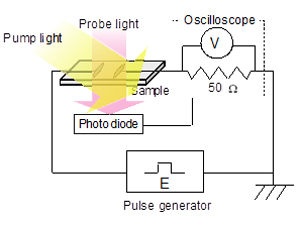 Figure 23:Simultaneous measurement system for conductance and transmittance change caused by a pulsed laser irradiation |
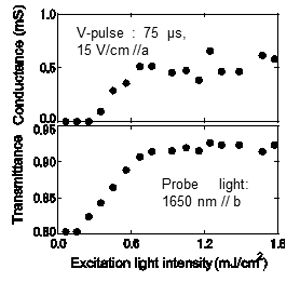 Figure 24:Excitation light intensity dependence of conductance and transmittance (peak values) when a pulsed laser was irradiated in α-(BEDT-TTF)2I3 thin film at 70 K. Pump light: Nd:YAG-OPO pulsed laser (450 nm, E//b) |
Assign: Oshima, Cui, Kato
The π-d molecular conductors show interesting physical phenomena, such as field-induced superconductivity or giant magneto-resistance, due to its non-negligible π-d interaction. The aim of this study is to control such interesting phenomena by flipping the local d spins or disturbing itinerant π-electrons by the use of electron spin resonance (ESR). Here, we have focused on the λ-(BETS)2FexGa1-xCl4 system which shows field-induced superconductivity (FISC) at high magnetic fields, and have studied whether the FISC state can be controlled by ESR transitions, which correspond to the spin-flips of d-electrons. Previously, simultaneous ESR and transport measurements were performed on λ-(BETS)2FexGa1-xCl4 (x=0.6), and we have observed a change in the resistance due to the ESR transitions since the resistance anomaly occurs at the same field position of the resonance field. To see the reproducibility of this above-mentioned behavior, we have tried the x=0.5 mixed compound. As shown in the Figure 25, the magnetoresistance shows some anomaly at the same position where ESR transitions occur. From our precise temperature dependence, we conclude that the FISC phase is partially destroyed by ESR transition. Due to the skindepth and weak power of the millimeter-wave irradiation, the resistance change by ESR is very limited since only the FISC state at the surface is destroyed. (BETS= bis(ethylenedithio)tetraselenafulvalene)
